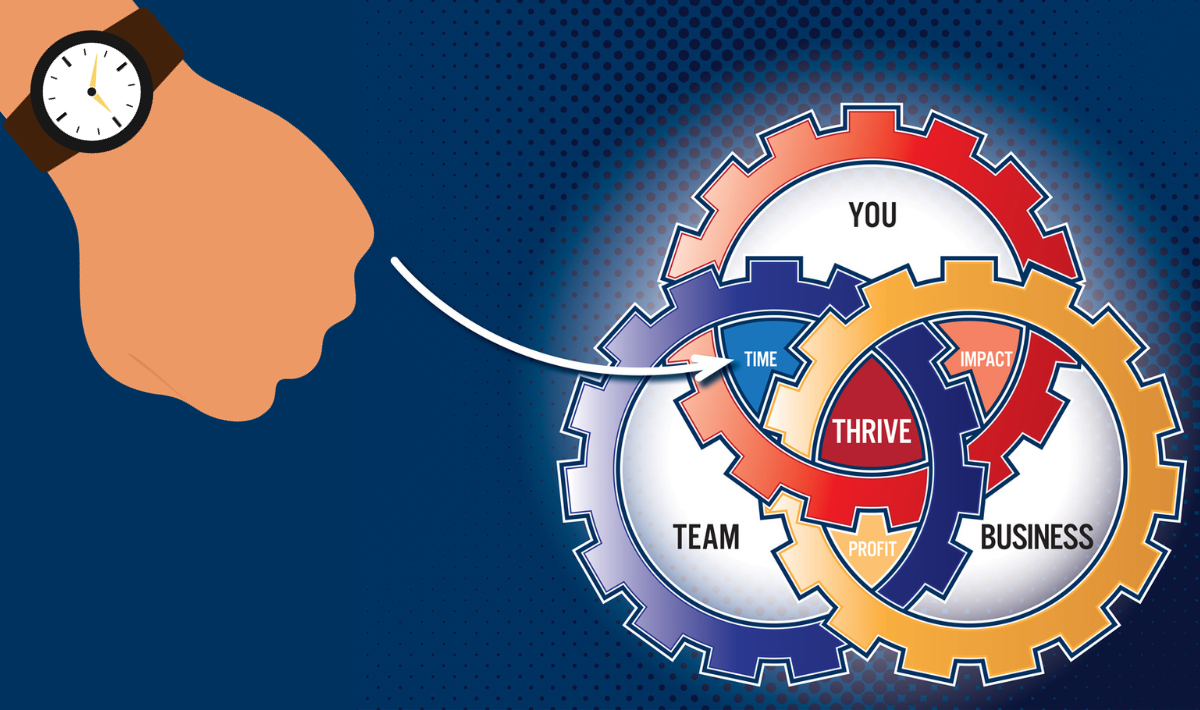How to leverage your most valuable resource to drive the greatest impact for your business.
Time is a dwindling resource for all of us.
Leaders especially know all too well the challenges of managing time as an organizational resource. You probably have more things that you need to get done inside your life than you have time to do them.
Fortunately, the DEO has a solution! While it isn’t a one-and-done fix, it is a process that you can implement for your practice as often as you need it. Because the truth is that the second you get your time allocation for your life and business in the right place, something else will get out of sync. That is the life of an entrepreneur. We are constantly building and taking on new things, which can create challenges for our existing ventures.
Finding an operating system that can help you plan and work efficiently is key to the success and operation of your business. The DEO Map is our approach to an operating system that is ideal for people who are building dental companies. It’s a simple operating system that we designed exclusively for our industry. Within this framework, you can guide the strategy and direction of your practice, create better avenues of communication with your team, and set better goals for your organization.
Getting the greatest output
Leverage is a word we use in the DEO a lot. The root word of leverage is lever, which is a force multiplier. When we use a lever to move something, we are getting more energy out of the lever than we can put in ourselves.
Take this concept of the lever and apply it to your life as a leader – what are the things that you can implement to get the greatest output? You are never going to have enough time to do all the things that you wish you could do in your business, so you need to use any available levers to pick the right things that have the maximum output. That way, everyone in the business wins.
First, you need to identify the unique skills and ways you can impact your organization. That can be accomplished by moving away from the multitasking mentality that so many leaders have and pivoting towards applying focus where it is needed most. Leadership is a heavy commitment, and you need to have a clear picture of what your days really look like.
To do that, audit your schedule and priorities for each day. Take stock of what you are currently doing, identify the “to-do list” that is not getting done, and reorganize your priorities around your findings. With this information, you can push the lower priority items downstream to other team members, allowing you to refocus and reprioritize your responsibilities based on the needs of your organization.
When you make an effort to prioritize the responsibilities and tasks that make the most sense for your role, you will likely find that you are a more effective member and leader of your organization. Reshaping that focus is a powerful management tactic that will, in a manner of speaking, clear the deck for forward momentum.
A key part of being a leader is making decisions based on the health and functionality of your organization. These decisions can range from something as simple as choosing new tools for your office to getting into the granular details of the daily processes. The challenge here is, again, leveraging your time in a way that allows you to focus on the details while improving the efficiency of the work itself. The best way to move forward is to identify those things that distract you from your goals and drain your energy.
Identifying the energy vampires around us
Everyone has an energy vampire of some sort. The traditional vampire lurks in darkness and comes in the night to drain you of your life force – an energy vampire (a term coined by author Jon Gordon) operates in the same way, but with more subtlety. Think about those tasks that you feel obligated to do but would give anything to not be responsible for doing. These are tasks that require a tremendous amount of emotional, mental, or even physical energy, and are sapping every bit of willpower you have left. You need to identify those energy vampires in the room and deal with them. It could be anything from paying taxes and answering emails to dealing with specific personnel issues. These obstacles will take control and rule your life if you allow them to.
It is a good practice to attach the term energy vampire to these things, because it identifies the obstacles that you are struggling with. When you are talking about topics like leverage, it’s important to know that energy vampires are negative leverage – they take away energy and efficiency from your daily processes.
Common mistakes are another form of energy vampires. There are plenty of ways to create efficiencies for yourself in the office and in your personal life, but it may involve changing the way you do things to get out of a rut.
Learning to delegate
We have all experienced energy vampires at some point in our career. Many of us experience them every day, but the goal is to reduce these will-sapping processes to improve our efficiency as well as our outlook in general. What is the best way to get rid of energy vampires? Delegation!
A huge part of leadership is learning how to delegate responsibilities. There are certainly plenty of things that you are good at doing and probably plenty of things that you enjoy doing, but it’s important to look at your list of tasks and responsibilities through the lens of time management. You don’t need to accomplish a hundred different things – you need to do a few things really well. Delegating responsibilities that are not a priority for leadership is the best way to find those few things that you can do really well.
Delegation is a process of communication: you are communicating new responsibilities for other teammates as well as certain expectations that come with the job. Like most processes, it’s not a one-and-done situation. It requires constant work and communication to refine your delegation process.
Here are some key questions to consider: Is every task you are doing an effective use of your time? How else can you divert your efforts and skillset to accomplish the goals of your organization? And perhaps the question at the center of everything – are you willing to let go of certain responsibilities? Are you establishing checkpoints to determine the quality of the work?
Let’s break those questions down a little further.
- Is every task you’re doing an effective use of your time? If you are still handling administrative tasks or other low priority responsibilities, this is absolutely not a good use of your time as a leader, no matter what your role is – CEO, dentist, executive or director. Your skillset would be better utilized by tackling the big picture challenges that your organization is facing. As the leader, you are expected to cast the vision for the future, and it’s impossible to do something like that while stuck in the daily administrative tasks required to operate your business. While that kind of work should never be beneath you, it can be taken over by someone else.
- How else can you divert your efforts and skillset to accomplish the goals of your organization? You are in a place of leadership because of a unique skillset that others may not be equipped with. Start by identifying those tasks and responsibilities that don’t reflect that skillset. If you are not a numbers person, it is time to hire someone that can dig into the minutiae of the day-to-day expenses and payroll. If you are not a great person to put on the phone, hire an awesome front office staff that can provide the warmth and attention that your patients deserve. It’s all about finding people that can round out your organization with different capabilities and strengths.
- Are you willing to let go of certain responsibilities? At the center of it all, you need to be willing to trust your team. An effective leader knows how to delegate and can pick out who to delegate certain tasks to – that ability to pick out high-performing individuals is how you can continue to grow your team. At the same time, you do not need super high-performing individuals in order to delegate responsibilities. A lot of us think that our team members need to be as good as we are – in reality, you only need someone who is 50% to 60% as good as you are.
- Are you establishing checkpoints to determine the quality of the work? We need to establish a point in the process where we check in on the health and progress of our teams. Ideally, there are several checkpoints to ensure that the work is being done correctly so you can course correct earlier rather than later. If you are not taking the time to ensure that the work and progress is in alignment with the goal and vision of your organization, are you really being effective with your resources?
Another way to approach the delegation process is to lower the bar for your team – you can still have high expectations while encouraging development at a scalable rate. In other words, you were not 100% great at your job when you started either. Give your team room to make mistakes and grow. Failure is a part of the growth process. If you don’t allow someone else to go through that transformative process, you are denying them the ability to grow and you are hurting your company.
Leverage your time, eliminate energy vampires, and trust in your team by delegating tasks. Try these three simple frameworks in the coming days and weeks. It may surprise you by how much more energy you have and the efficiencies you create in the process.





